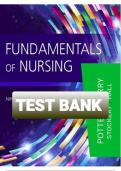,MULTIPLE CHOICE
1. A nurse is teaching staff about the conduction of the heart. In which order will the nurse
present the conduction cycle, starting with the first structure?
1. Bundle of His
2. Purkinje network
3. Intraatrial pathways
4. Sinoatrial (SA) node
5. Atrioventricular (AV) node
a. 5, 4, 3, 2, 1
b. 4, 3, 5, 1, 2
c. 4, 5, 3, 1, 2
d. 5, 3, 4, 2, 1
ANS: B
The conduction system originates with the SA node, the ―pacemaker‖ of the heart. The electrical
impulses are transmitted through the atria along intraatrial pathways to the AV node. It assists
atrial emptying by delaying the impulse before transmitting it through the Bundle of His and the
ventricular Purkinje network.
2. A nurse is teaching the patient with mitral valve problems about the valves in the heart.
Starting on the right side of the heart, describe the sequence of the blood flow through these
valves.
1. Mitral
2. Aortic
3. Tricuspid
,4. Pulmonic
a. 1, 3, 2, 4
b. 4, 3, 2, 1
c. 3, 4, 1, 2
d. 2, 4, 1, 3
ANS: C
The blood flows through the valves in the following direction: tricuspid, pulmonic, mitral, and
aortic.
3. A nurse explains the function of the alveoli to a patient with respiratory problems. Which
information about the alveoli’s function will the nurse share with the patient?
a. Carries out gas exchange
b. Regulates tidal volume
c. Produces hemoglobin
d. Stores oxygen
ANS: A
The alveolus is a capillary membrane that allows gas exchange of oxygen and carbon dioxide
during respiration. The alveoli do not store oxygen, regulate tidal volume, or produce
hemoglobin.
4. A nurse auscultates heart sounds. When the nurse hears S2, which valves is the nurse hearing
close?
a. Aortic and mitral
b. Mitral and tricuspid
c. Aortic and pulmonic
d. Mitral and pulmonic
, ANS: C
As the ventricles empty, the ventricular pressures decrease, allowing closure of the aortic and
pulmonic valves, producing the second heart sound, S2. The mitral and tricuspid produce the first
heart sound, S1. The aortic and mitral do not close at the same time. The mitral and pulmonic do
not close at the same time.
5. The nurse is teaching about the process of exchanging gases through the alveolar capillary
membrane. Which term will the nurse use to describe this process?
a. Ventilation
b. Surfactant
c. Perfusion
d. Diffusion
ANS: D
Diffusion is the process of gases exchanging across the alveoli and capillaries of body
tissues.Ventilation is the process of movN inUgRgSaIN
seGsTiBn.tCoOaM
nd out of the lungs. Surfactant is a
chemical produced in the lungs to maintain the surface tension of the alveoli and keep them from
collapsing. Perfusion is the ability of the cardiovascular system to carry oxygenated blood to
tissues and return deoxygenated blood to the heart.
6. A nurse is caring for a patient who was in a motor vehicle accident that resulted in cervical
trauma to C4. Which assessment is the priority?
a. Pulse
b. Respirations
c. Temperature
d. Blood pressure
ANS: B
Respirations and oxygen saturation are the priorities. Cervical trauma at C3 to C5 usually results
in paralysis of the phrenic nerve. When the phrenic nerve is damaged, the diaphragm does not
descend properly, thus reducing inspiratory lung volumes and causing hypoxemia. While pulse




